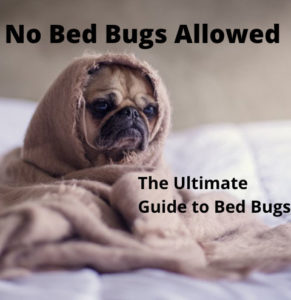 Bed bugs can live (and thrive) anywhere humans live. From the fanciest hotels, to small apartments, to your home.
Bed bugs can live (and thrive) anywhere humans live. From the fanciest hotels, to small apartments, to your home.
Bed Bugs are extremely difficult to control. To completely get rid of bed bugs, you need a complete understanding of how to identify, treat, and prevent an infestation.
The best way to defend against bed bugs (and bed bug bites) is to educate yourself and the other people in your home.
We’ll answer some of our most frequently asked bed bug questions.
WHAT ARE BED BUGS?
Bed bugs feed on blood and particularly like human blood. Adult bed bugs don’t have wings and look like an apple seed in size, shape, and color.
Bed bugs look for wherever humans sleep. That’s because they mostly feed at night. Once they find a suitable building they can reproduce rapidly.
Their primary food source is human blood but unlike other parasitic bugs like ticks, they do not stay attached to their blood source. They eat, and then go back to their home and hide/live and grow.
HOW DO I GET BED BUGS?
The good news is you cannot just “get” Bed Bugs. Bed Bugs are brought into your home. One of the first clues that you may have brought bed bugs into your home is in your luggage after a trip or a used piece of furniture bought at a garage sale.
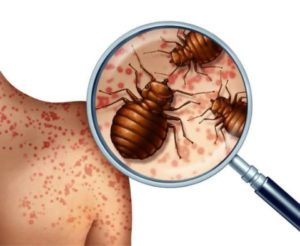
Typically, you will discover you have Bed Bugs after you wake from sleep finding yourself itching with unexplainable bites on your body. The more challenging scenario is that the homeowner may not react to the bed bites at all, which will allow the Bed Bug infestation to grow larger.
WHAT DO BED BUG BITES LOOK LIKE?
While bed bug bites may irritate your skin, the good news is, this is temporary and does not spread any disease.
The actual bite mark looks similar to other bites like a mosquito bite.
Bed bug bites can cause rashes and raised clusters on the skin.
But the typical worst case scenario is a severe allergic reaction and raised rash marks on your skin.
WHAT DO BED BUGS LOOK LIKE?
A bed bug’s size and appearance depends on its stage in life.
The primary characteristic of an adult Bed Bug is a small head.
Their bodies are flat and oval shaped with six legs and two antennae. Their color is rust-reddish color and as they feed their color deepens.
The challenge with identifying Bed Bugs is that the newly hatched bed bug, known as a nymph, is about the size of the head of a pin and off-white coloring.
DO BED BUGS SPREAD DISEASE?
No. There is no research that has shown Bed Bugs spread disease.
The most common (and serious) health problems come from getting bitten by bed bugs. Their bites will become itchy and can become infected.
Understandably, it’s also hard to sleep in a room with bed bugs. Sleep deprivation is a common side effect of your new roommates.
HOW DO YOU GET RID OF BED BUGS?
Bed bugs are tough. They can live for a year without a meal.
They can survive in any climate with temperatures from 0 to 125 degrees Fahrenheit. That’s quite a range.
Even worse, you can’t just kill these guys with bug spray from the store.
How do you get bed bugs out of your house?
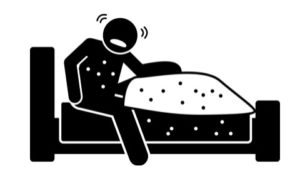 You need a thorough approach to get rid of a bed bug infestation.
You need a thorough approach to get rid of a bed bug infestation.
- Get rid of any clutter so bed bugs have fewer places to hide.
- Wash all of your clothes, blankets, bedspreads, and pillowcases in hot water. The dry everything with high heat for at lest 30 minutes.
- Thoroughly vacuum all of your carpets. Wen you’re done, seal and throw away the vacuum bag in an outside trash can. Make sure bugs can’t get back in your house.
- Call an exterminator
A lot of people want to try to get rid of bed bugs themselves. But please, we can’t recommend an exterminator enough. It’s nearly impossible for DIY to completely get rid of an infestation.
We especially don’t recommend foggers. They do not reach all crevices where bed bugs hide.
Because bed bugs are so difficult to get rid of, we recommend getting help from a professional pest control company.
A pest expert can help you identify and locate the bed bugs in your home and can give you a treatment plan to get rid of the bugs permanently.
HOW MUCH DOES A BED BUG EXTERMINATOR COST?
How much does a bed bug exterminator cost? It depends on the size of your home. Bigger apartments and houses will cost more.
Has your bed bug treatment worked?
It’s hard to tell right away if the bed bugs are gone for good. Why? A few reasons.
Whole Room Heat Treatments
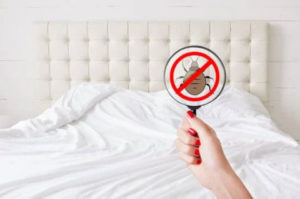 Whole room heat treatments involve a Pest Management Professional (PMP) bringing in specially designed equipment to raise the temperature in your home to kill the bed bugs. Scientifically speaking, a bed bug and egg die within 90 minutes at 118°F (48°C) or immediately at 122°F (50°C). During a heat treatment, the air temperature in the room is typically between 135°F (57.2°C) and 145°F (62.7 °C). The (PMP) will place remote thermometers throughout the home and watches the thermometers closely to ensure that it gets hot enough to kill bed bugs. A heat treatment typically takes between six and eight hours, depending on the condition of the area being treated.
Whole room heat treatments involve a Pest Management Professional (PMP) bringing in specially designed equipment to raise the temperature in your home to kill the bed bugs. Scientifically speaking, a bed bug and egg die within 90 minutes at 118°F (48°C) or immediately at 122°F (50°C). During a heat treatment, the air temperature in the room is typically between 135°F (57.2°C) and 145°F (62.7 °C). The (PMP) will place remote thermometers throughout the home and watches the thermometers closely to ensure that it gets hot enough to kill bed bugs. A heat treatment typically takes between six and eight hours, depending on the condition of the area being treated.
Your home can become re-infested after heat treatments. You or your exterminator must take steps to prevent a re-infestation. This is usually a long lasting insecticide applied around the home or room being treated.
Insecticide Treatments for Bed Bugs
Insecticide treatments that are conducted thoroughly and correctly by a licensed PMP can be a very effective way of controlling bed bugs. Three different types of insecticides should be used in order to achieve the best result. There are many different brands of insecticides but one of each of the following broad categories should be used.
- A fast-acting, contact insecticide for use on surfaces that humans frequently touch, i.e. sofas.
- A residual insecticide for inside furniture, cracks and crevices and the underside of surfaces we touch.
- A dust insecticide for cracks, crevices and voids, such as electrical outlets and baseboards.
Your PMP may offer other services such as container heat treatments, steam applications, or freezing infested items. Usually, items treated with these optional controls do not require an insecticide treatment and therefore fewer insecticides are needed.
 A thorough insecticide treatment should involve 2-3 visits from the PMP, as it is unlikely all the bed bugs will be killed in the initial treatment.
A thorough insecticide treatment should involve 2-3 visits from the PMP, as it is unlikely all the bed bugs will be killed in the initial treatment.
An insecticide treatment typically takes about 30 minutes to 2 hours per room depending on size and condition of the room. Once the treatment is complete you should wait until all the insecticides have dried before reentering your home, or until the PMP says it is safe to re-enter.
Before any treatment the PMP should provide you with a detailed list of instructions for how to prepare your home. It is very important to follow these directions closely as properly preparing the home is a very important step in any treatment process. Improper preparation is one of the main reasons bed bug treatments fail.
We strongly recommend against trying to conduct a bed bug insecticide treatment by yourself. Controlling bed bugs with insecticides is a challenging and time consuming process which requires expertise and in many states a license is required to apply the insecticides which kill bed bugs. The insecticides that can be purchased in a hardware store, such as foggers, are not effective in controlling bed bugs and we strongly recommend against their use.
Typical places To Look For Bed Bug Skins?
- Along mattress seams
- Behind headboards
- In ceiling/wall junctions
- Along baseboards
- Stuck to personal belongings
WHERE DO BED BUGS COME FROM?
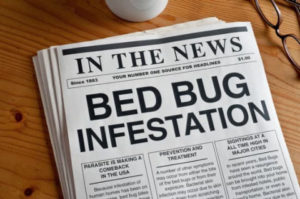 It seems as if they’ve have re-emerged in recent years.
It seems as if they’ve have re-emerged in recent years.
But the reality is that bed bugs that are infesting homes today are the great-great-great-great grandchildren of cave dwelling bugs that originally fed on the blood of bats.
It is safe to say that when humans began lived in the caves; bugs began feeding on humans. Later, when humans moved out of the caves and started their agricultural civilizations, the bugs moved with them. Since that time, humans have carried bed bugs all over the world.
Bed bugs belong to a family of insects called Cimicidae. All members of this insect family feed exclusively on blood. There are five developmental life stages of the Bed Bug. Each immature life stage (called nymphs or instars) must take a blood meal in order to develop into the next life stage. Because bed bugs, like all insects, have their skeleton on the outside of their body (exoskeleton) they have to shed their exoskeleton in order to grow larger. This shedding of the outside of their body ”skin” is called molting. While the molting process is a necessary stage of development of the Bed Bug, the cast off molts can help identify where Bed Bugs are hiding.
A bed bug nymph must take a blood meal to molt successfully. After growing through five instar molts, the bed bug becomes an adult. Adult bed bugs, both male and female, must also take regular blood meals to reproduce. An adult bed bug have a life span of nearly one year depending on regular access to blood meals and favorable temperatures.
ADDITIONAL RESOURCES SECTION
Bed Bug Info and Fact Sheet: English
Bed Bug Info and Fact Sheet: Spanish
Bed Bug Info and Fact Sheet: French
Bed Bug Info and Fact Sheet: Polish
Bed Bug Info and Fact Sheet: Mandarin Chinese
The Tenant Checklist – What to do if you suspect you have Bed Bugs
Tenant Checklist: Mandarin Chinese

